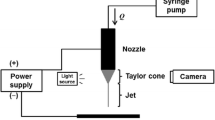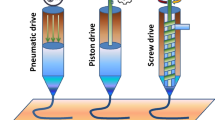Abstract
In order to improve the printing quality, this study focused on the thermo-fluid-solid coupling process of ink roller-ink. One of the highlights of this study is to consider the influence of temperature on the rubber hyperelastic parameters, viscoelastic parameters, and ink viscosity. The other highlight is to improve the elastohydrodynamic lubrication theory and Hertz contact theory through the rubber elastic modulus, which is determined by the relaxation curve considering the temperature and working conditions. Furthermore, based on the improved theory, the thermo-fluid-solid coupling model of ink roller-ink was established. Finally, the effect of temperature on the coupling process was analyzed. The results show that under the working conditions, with increasing temperature from 20 °C to 40 °C, the contact half-width increases from 4.2335 mm to 4.4701 mm, and the minimum ink film thickness decreases from 0.5097 mm to 0.1410 mm, and the maximum ink pressure decreases from 0.6802 MPa to 0.6618 MPa.
Similar content being viewed by others
Abbreviations
- W M-R :
-
Mooney-Rivlin strain energy function
- C 10, C 01 :
-
Material coefficients characterizing shear deformation of materials
- I 1, I 2 :
-
The first, second strain invariants
- d :
-
Incompressible coefficient, d are approximately 0 when incompressible
- J :
-
Elastic volume ratio, approximately equal to 1 under small deformation
- σ :
-
Cauchy stress (MPa)
- G 0 :
-
0 time shear relaxation modulus (MPa)
- α i :
-
Relative relaxation modulus
- T i :
-
Relative relaxation time (s)
- C 1, C 2 :
-
Empirical constant, related to temperature
- T :
-
Current temperature (k)
- T 0 :
-
Selected reference temperature (k)
- η :
-
Apparent viscosity of non-Newtonian fluid (Pa·s)
- η(Y):
-
Viscosity-shear rate function, different expressions for different models
- H(T):
-
Related to the viscosity-temperature function and represents the viscosity-temperature relationship of the fluid
- η(T):
-
The function of viscosity-temperature
- σ(T 0 ) :
-
The viscosity-temperature relationship under the reference temperature T0
- k :
-
Consistency coefficient, the value of this article is 270.78 kg/(m·s) [30]
- n :
-
Power law behavior index, this article takes the value 0.7939 [30]
- A :
-
Pre-factor, also known as experimental constant (Pa·s)
- E a :
-
Viscous activation energy (J/mol)
- R :
-
Gas constant or thermodynamic constant, generally R = 8.314 J/(mol·K)
- h :
-
Film thickness (m)
- h 0 :
-
Center film thickness, determined according to load balance conditions (m)
- R 0 :
-
Equivalent radius of curvature, \({1 \over {{R_0}}} = {1 \over {{R_1}}} + {1 \over {{R_2}}}\)
- R 1, R 2 :
-
Radius of steel roller and rubber roller (m)
- E :
-
The composite elastic modulus of the two contact surfaces (Pa), \({1 \over E} = {1 \over 2}\left[ {{{1 - U_1^2} \over {{E_1}}} + {{1 - U_2^2} \over {{E_2}}}} \right]\)
- E 1, E 2 :
-
Elastic modulus of steel and rubber (Pa)
- U 1, U 2 :
-
Poisson’s ratio of steel and rubber
- p :
-
Pressure (N)
- c :
-
An undetermined coefficient
- η 0 :
-
Viscosity when p = 0, T = T0 (Pa·s)
- p 0 :
-
Viscosity-pressure coefficient, take p0 = 2.57×10−8 (m2/N)
- z :
-
Coefficients in the viscosity formula, for ink z = 0.68 [29]
- h T :
-
Film thickness considering temperature (m)
- E T :
-
The composite elastic modulus of the two contact surfaces considering temperature (Pa), \({1 \over {{E^T}}} = {1 \over 2}\left[ {{{1 - U_1^2} \over {{E_1}}} + {{1 - U_2^2} \over {E_2^ \ast ({\rm{time}},{\rm{Temp}})}}} \right]\)
- E*2(time, Temp):
-
Instantaneous modulus of elasticity considering temperature and relaxation time (Pa)
- p T :
-
Pressure considering temperature (N)
- b :
-
Contact half width (m)
- Y 2 :
-
Loss modulus (Pa)
- ω :
-
Frequency (Hz)
- σ 0 :
-
Stress amplitude (Pa)
- ε 0 :
-
Strain amplitude
- δ :
-
Stress strain phase difference (°)
- ω c :
-
Actual frequency of rubber roller contact area (Hz)
- δ c :
-
Actual stress and strain phase difference (°)
- ΔW ci :
-
The hysteresis heat generation of the i-th node on the centerline (J)
- d 2 :
-
Rubber roller diameter (m)
- L :
-
Rubber roller length (m)
- s :
-
Rubber layer thickness (m)
- r :
-
Rotating speed (rpm)
- t :
-
Turning time (min)
- F :
-
Load force (N)
- T r :
-
Rotation period (s)
- T p :
-
Contact time (s)
- C :
-
Specific heat capacity, value 1600 for rubber [J/(kg·°C)]
- m :
-
Rubber quality (kg)
- ρ :
-
Rubber density (kg/m3)
- V :
-
Rubber volume (m3)
References
B. Li, K. Yang, P. Xu, J. Xu, M. Yuan and M. Zhang, An experimental study on permeability characteristics of coal with slippage and temperature effects, Journal of Petroleum Science and Engineering (2019) 175.
F. Chen, M. Zhang, J. Qian, L. Chen and Z. Jin, Pressure analysis on two-step high pressure reducing system for hydrogen fuel cell electric vehicle, International Journal of Hydrogen Energy, 42(16) (2017) 11541–11552.
P. Yu, W. Ma, W. Villanueva, A. Karbojian and S. Bechta, Validation of a thermo-fluid-structure coupling approach for RPV creep failure analysis against FOREVER-EC2 experiment, Annals of Nuclear Energy (2019) 133.
M. J. Li et al., Heat transfer and thermal stress analysis in fluid-structure coupled field, Applied Thermal Engineering (2015) 473–479.
S. Yun, J. Kwon, D. C. Lee, H. H. Shin and Y. Kim, Heat transfer and stress characteristics of additive manufactured FCCZ lattice channel using thermal fluid-structure interaction model, International Journal of Heat and Mass Transfer, 149 (2020) 119187.
A. A. Partoaa, M. Abdolzadeh and M. Rezaeizadeh, Effect of fin attachment on thermal stress reduction of exhaust manifold of an off road diesel engine, Journal of Central South University, 24(3) (2017) 546–559.
F. Meng et al., Multi-ellipsoid contact elastohydrodynamic lubrication performance for deep groove ball bearing, Tribology International, 150 (2020) 106367.
N. A. H. Tsuha and K. L. Cavalca, Stiffness and damping of elastohydrodynamic line contact applied to cylindrical roller bearing dynamic model, Journal of Sound and Vibration (2020) 481.
F. Schwack et al., A study of grease lubricants under wind turbine pitch bearing conditions, Wear (2020) 203335.
N. Tala-Ighil, M. Fillon and P. Maspeyrot, Effect of textured area on the performances of a hydrodynamic journal bearing, Tribology International, 44(3) (2010) 211–219.
W. Habchi, P. Vergne, S. Bair, O. Andersson, D. Eyheramendy and G. E. Morales-Espejel, Influence of pressure and temperature dependence of thermal properties of a lubricant on the behaviour of circular TEHD contacts, Tribology International, 43(10) (2009) 1842–1850.
S. L. Kahraman, A transient mixed elastohydrodynamic lubrication model for spur gear pairs, Journal of Tribology, 132(1) (2010) 011501.
A. Jurkiewicz, M. Pawlikowski and Y. Pyryev, Analytical, numerical and experimental analysis of the relationship between two rollers axes distance and the contact zone, International Journal of Mechanical Sciences, 131–132 (2017) 722–727.
A. C. T. Aarts et al., The pressure distribution in nips of systems of flexible rubber-covered rollers, International Journal of Mechanical Sciences, 64(1) (2012) 155–164.
P. E. Austrell and A. K. Olsson, Two-dimensional elastic contact model for rubber covered rollers, Plastics Rubber and Composites, 42(7) (2013) 269–275.
I. Bijelić et al., The influence of the contact pressure on the value of the coefficient of friction, Tribology in Industry, 39(2) (2017) 255–259.
W. Liu and J. Wang, Simulation and experiments research on the static and dynamic characteristics of rubber suspension, Mechanical Research and Application, 1 (2014) 99–101 (in Chinese).
P. J. Flory and J. Rehner, Statistical mechanics of cross-linked polymer networks, I. Rubberlike elasticity, Journal of Chemical Physics, 11(11) (1943) 512–520.
H. M. James and E. Guth, Theory of the elastic properties of rubber, Journal of Chemical Physics, 11(1) (1943) 455–481.
R. Christensen, Theory of Viscoelasticity: An Introduction, Elsevier (2012).
M. T. Shaw and W. J. MacKnight, Introduction to Polymer Viscoelasticity, John Wiley and Sons (2005).
R. Jin, Polymer Physics, 3rd Edition, Chemical Industry Press, Beijing (2009) (in Chinese).
H. Chu et al., Establishment of rubber thermo-viscoelastic constitutive model and analysis of temperature field, IOP Conference Series Materials Science and Engineering, 531 (2019) 012042.
P. Liu, Study on technical methods of online measurement and control for printing quality in offset press, Ph.D. Thesis, Northwesten Polytechnical University, Xian (2014).
F. P. Liu, Numerical calculation and experimentation of permeating depth of power-law printing ink in porous paper printing, Chinese Journal of Process Engineering, 7(2) (2007) 216–222.
R. B. H. Kacem et al., Contribution to modeling the viscosity Arrhenius-type equation for some solvents by statistical correlations analysis, Fluid Phase Equilibria (2014) 11–19.
B. Ji and J. Chen, ANSYS ICEM CFD Meshing Technology Example Detailed Explanation, China Water and Power Press, Beijing (2011) (in Chinese).
R. An, Analysis on temperature field of printing ink based on thermal elastohydrodynamic lubrication, Master’s Thesis, Beijing University of Technology, Beijing (2017) (in Chinese).
P. Huang, Numerical Calculation Method of Elastohydrodynamic Lubrication, Tsinghua University Press, Beijing (2013) (in Chinese).
H. Chu, X. Lin and L. Cai, Analysis of temperature characteristics of ink fluid based on power law model in microchannel, Advances in Mechanical Engineering, 11(3) (2019) 16878140 1983358.
Acknowledgments
This study was supported by the National Natural Science Foundation of China (No.51675010), the Beijing Natural Science Foundation (No.3192003), the Tribology Science Fund of State Key Laboratory of Tribology (No. STLEKF16A02 and SKLTKF19B08), the training program of Rixin talent, and outstanding talent from Beijing University of Technology, China.
Author information
Authors and Affiliations
Corresponding author
Additional information
Hongyan Chu is an Associate Professor in the School of Mechanical Engineering and Applied Electronics Technology, Beijing University of Technology, China. She received her Ph.D. in Beijing University of Technology. Her main research directions are the dynamic characteristics of roller system structures, intelligent manufacturing, process simulation and optimization of thermal processing.
Caixia Zhang is an Associate Professor in the School of Mechanical Engineering and Applied Electronics Technology, Beijing University of Technology, China. She received her Ph.D. in Mechanical Engineering from Tsinghua University. She focuses on the fields of harmonic drive in robot, bio-tribology, superlubricity and lubrication control.
Rights and permissions
About this article
Cite this article
Chu, H., Hong, Y., Zhang, C. et al. Establishment and analysis of thermo-fluid-solid coupling model of ink roller-ink under dynamic pressing contact. J Mech Sci Technol 35, 2915–2927 (2021). https://doi.org/10.1007/s12206-021-0615-z
Received:
Revised:
Accepted:
Published:
Issue Date:
DOI: https://doi.org/10.1007/s12206-021-0615-z




